Tag Archive: visual supports
July 25, 2012
by Carole Zangari -
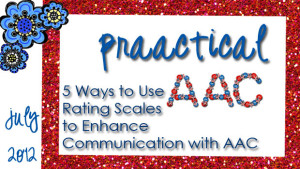
In an earlier post, we lamented the under-utilization of a quick and effective strategy: qualitative rating scales. You may not know them by that name, but we all know them. Also called Likert-type scales, we’ve seen these a multitude of times when we were asked to give an opinion. Strongly agree to Strongly Disagree. Excellent to Poor. Always to Never. – There are only a few guidelines to using these with AAC folks. One is to make sure to use appropriate visual supports. Literate AAC users may be very comfortable with text-only options, but for other learners, we need to add images so it makes sense to them. Another suggestion is to stick with an odd number of options: 5 seems to be the norm in clinical practice, but you can certainly adjust to fit the learner’s needs. For some, a 3-point scale would be best. Others may want more... [Read More...]
Filed under: PrAACtical Thinking
Tagged With: implementation ideas, intervention, rating scale, visual supports
July 22, 2012
by Carole Zangari -
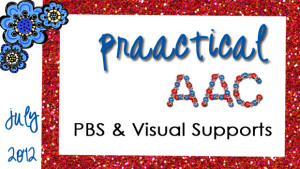
This week’s video comes from Katie Thomas of the Autism and Tertiary Behavior Supports Project of the Kansas Technical Assistance Network and deals with the who, what, when, where, and why of using visual supports to promote positive behavior. – There are several supporting documents including the PowerPoint handout, and some of the supports they review (e.g., calendar, first/then, wait card). We love the detailed description and the many examples they share. – Click here to view the video. –
Filed under: Video of the Week
Tagged With: ASD, behavior, implementation ideas, intervention, resources, visual supports
July 21, 2012
by Carole Zangari -
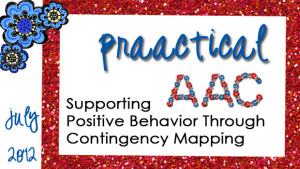
This month we’re focusing on visual supports and strategies to support positive behavior. We’ve talked about transition supports and environmental arrangements. Another way to help therapy sessions run smoothly and keep the focus on learning (rather than managing behavior) is to take proactive steps to make the expectations clear. For most people who are learning AAC, that means making sure there is a visual representation that accompanies the verbal explanation. – Many SLPs create a list of rules for expected behavior. In this post, we’ll talk about the research-supported strategy of using contingency maps. Contingency maps are a visual depiction that shows the desired behavior and the outcomes of two divergent paths: one where the learners engage in the desired behavior and the other that shows what happens if they don’t engage in the desired behavior. If you’re familiar with behavioral approaches, this strategy is right up your alley. The... [Read More...]
Filed under: Strategy of the Month
Tagged With: ASD, behavior, contingency map, developmental disability, intellectual disability, positive behavior support, visual supports
July 15, 2012
by Carole Zangari -
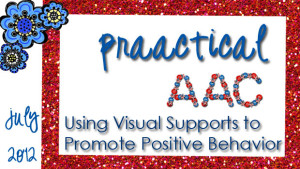
This week we have a series of short videos from the Geneva Centre for Autism on strategies to support positive behavior. Enjoy these explanatory videos on Supporting Positive Behaviors During Changes, Change in Routine, and Learning to Wait. –
Filed under: Video of the Week
Tagged With: ASD, behavior, implementation ideas, intervention, visual supports
July 14, 2012
by Robin Parker -
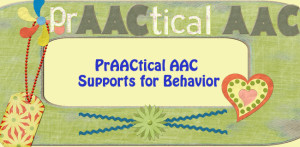
Our July Strategy of the Month, PrAActical AAC Supports for Behavior, is a favorite topic for us, because with a little planning, we can adhere to the old adage that an ‘ounce of prevention is worth a pound of cure’ (as Carole said last week). We also find that behavior challenges are often one of the main reasons, our students (and colleagues) get stressed about working with children with significant communication impairments. And since stress for ANYONE does not make for an optimal learning environment, we love to show how effective preventative strategies work. This week we are focusing on ‘setting the stage’ for conventional and appropriate behavior by engineering the physical environment. We are talking about more than keeping the room neat, clean, and generally organized. We are talking about arranging the physical environment in a planned and careful way in order can make a huge difference in helping... [Read More...]
Filed under: Strategy of the Month
Tagged With: behavior, behavior management, visual supports
July 8, 2012
by Carole Zangari -
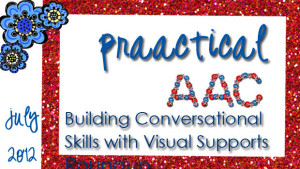
A young AAC user whom I know shared a story with me recently about feeling left out and struggling to find out why. Although she is smart, has age appropriate receptive language, and good command of her high tech SGD, building and maintaining friendships is a struggle. One of the things we’ll be doing to make changes in that area is to learn more about what makes a good conversation, adding vocabulary to make small talk easier, and practicing that. – Here’s a nice video, from Autism Teaching Strategies, that shows how to use visual supports and music to help learners remember to use some of the conversational continuers. Although Joel Shaul demonstrates this with visual supports that have words and phrases, the strategy works just as well with pictures for pre-literate communicators. – – Enjoy!
Filed under: Video of the Week
Tagged With: Conversation, intervention, pragmatics, visual supports
July 7, 2012
by Carole Zangari -
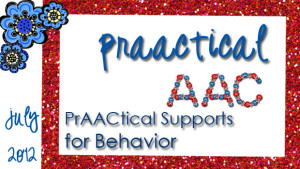
Rachel arrives to therapy tense and upset. Mauro gets frustrated when the clinician presents new activities. Brianna starts to bang the table when demands are placed on her. Zach becomes agitated when he has to wait for something he wants. – Like any set of tools and strategies, AAC works best when the communicator is relaxed, confident, and engaged. Our July Strategy of the Month focuses on PrAACtical Supports for Behavior. We hope to share ideas for planning therapy sessions that help AAC learners stay focused, calm, and engaged. — We’re big believers in the old adage that an ounce of prevention is worth a pound of cure. So, what can we do to prevent or minimize problems like the ones experienced by Rachel, Mauro, Brianna, and Zach? The answers have to do with having clear and appropriate expectations, and using visual and AAC supports effectively. When used consistently, these strategies... [Read More...]
Filed under: Strategy of the Month
Tagged With: aided language input, ASD, behavior, countdown board, developmental disability, first then, intervention, picture schedule, positive behavior support, transition, visual supports
June 24, 2012
by Carole Zangari -
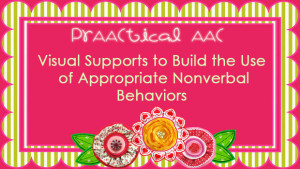
Most of our posts are about teaching language, but today we take a little side trip into nonverbal communication. We’ve all worked with folks who have difficulty maintaining appropriate distance and making eye contact, and know how problems in these area can really impede a person’s ability to relate well to others. Our video for this week, from Autism Teaching Strategies, illustrates how to use pictures supports to teach appropriate nonlinguistic conversational behaviors. – Of course, we were drawn to it because of our own experience that using pictures as a reminder is much easier to fade than oral language prompts (e.g., ‘Don’t forget to look at me when you talk;’ ‘Quiet hands’). – What we also love about this video is the teaching strategy: role reversal. In this strategy, the SLP (or teacher/parent) provides a model of both positive and negative examples of the target skill. The learner’s job... [Read More...]
Filed under: Video of the Week
Tagged With: Conversation, intervention, visual supports
June 20, 2012
by Carole Zangari -
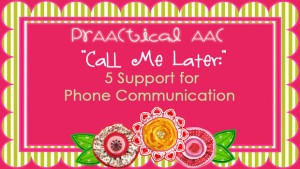
While I am not one of those folks who has a phone glued to her ear, I sure wouldn’t want to live without the ability to make a phone call. Here are some sites with information of interest to people with AAC needs. 1. Photo Phone Dialing: While many high tech SGDs can do phone dialing, sometimes the best solution is the simplest one. For some people, using a phone that has prestored numbers stored under photo buttons, provides just enough support to make the call. Once the call is placed, however, out comes the SGD so the conversation can proceed. – 2. Phone Skills: We’re not born knowing how to use the phone and some of our AAC friends have needed direct instruction and lots of practice phone skills. Making visual supports, like this one from SET BC, can help. Another neat tool is the Tele-Trainer, which is a... [Read More...]
Filed under: PrAACtical Thinking
Tagged With: implementation ideas, phone, resources, visual supports
June 5, 2012
by Robin Parker -

We have to commend and thank a classroom teacher who made it her priority to learn and share information about visual supports and communication. She developed a great wiki with many awesome visual support downloads. She worked with a mentor through the Florida Partnership for Effective Programs for Students with Autism (PEPSA). The mission of this great program is to enhance the education for students with autism spectrum disorders. With projects like this, the education of everyone is enhanced. The visual supports are for PrAACtical activities and learning. Find your favorite and then apply language facilitation strategies when teaching communication with the symbols. Check this out at: http://pkautismvisuals.wikispaces.com/Welcome Academic Supports Basic Communication Daily Routines Fun and Games
Filed under: PrAACtical Thinking
Tagged With: PEPSA, visual supports









